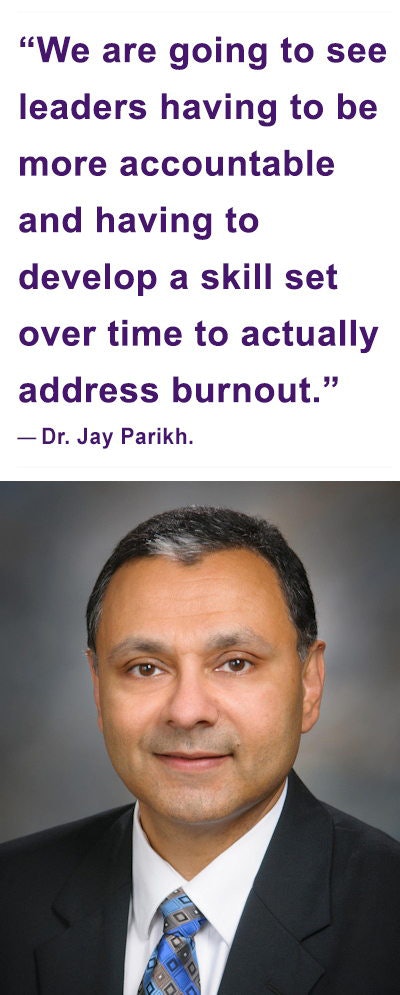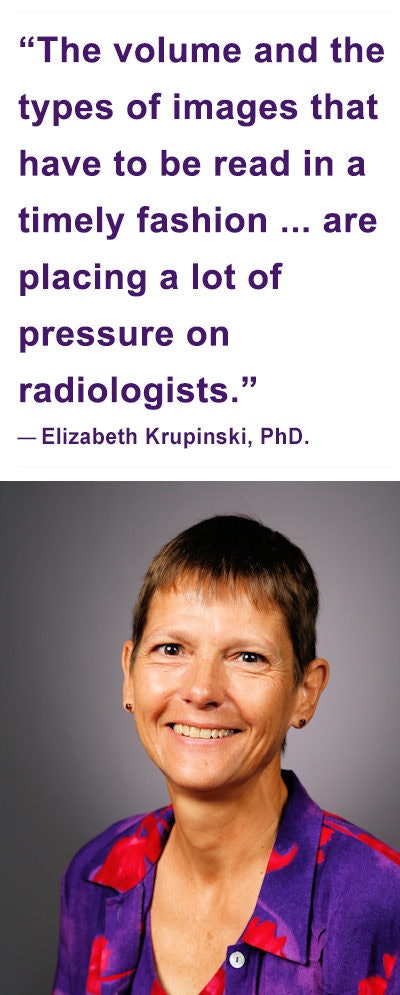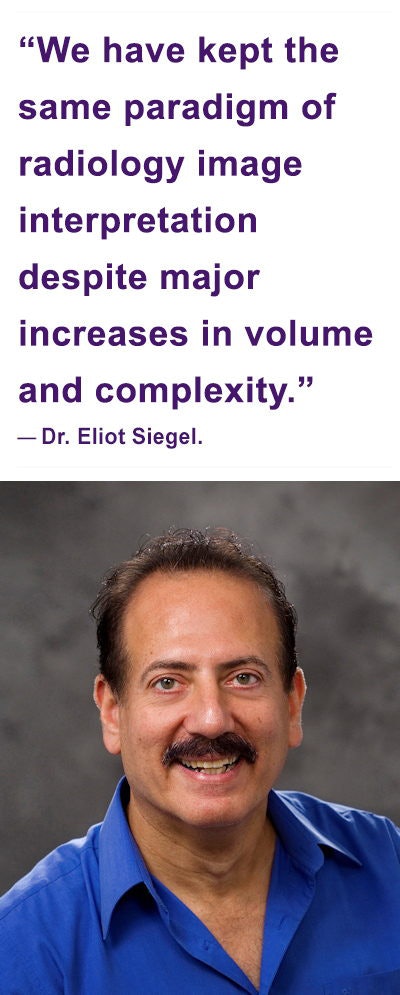
Radiologist burnout is real. Pressed to do more, and to get what they do right, many radiologists become frustrated and burn out. But what are the solutions to radiologist burnout, and will they actually work?
Radiologists are at greater risk for burnout than most other physicians, according to the American College of Radiology (ACR). Causes include isolation in the reading room, productivity demands, implementation of the electronic medical record (EMR) and PACS, the regulatory environment, and ambiguity about the radiologist's role on the healthcare team.
When feeling burnout, radiologists may experience a lack of motivation for their work, as well as a lack of compassion when working with patients and physicians. They may find it difficult to concentrate, lack energy, and may become disillusioned and cynical.
Data show a continued increase in burnout rates among radiology professionals. In 2011, about half of radiologists reported burnout. This increased to about 60% in 2014. For radiation oncologists, it rose from about 30% in 2011 to about 40% in 2014, according to the ACR.
A study published in 2020 in the Journal of Breast Imaging found a high prevalence of burnout among breast imaging radiologists.
Lead author Dr. Jay Parikh of MD Anderson Cancer Center described three fundamental dimensions of burnout:
- Feelings of a lack of accomplishment and ineffectiveness -- feelings of incompetence and a lack of achievement and productivity in work
- Emotional exhaustion -- feeling overextended by work demands, without a source of replenishment or recovery
- Depersonalization, with associated cynicism towards the job -- a negative, callous, detached response to the job
Investigators assessed the presence of these dimensions in a survey of 370 breast imaging radiologists. They discovered that 78.4% of respondents were highly burned out in at least one measured dimension of burnout, 54.4% were highly burned out in at least two dimensions, and 7.5% were highly burned out in all three dimensions.
What's driving burnout?
Burnout is a prolonged response to chronic interpersonal stressors on the job, Parikh said in an interview with AuntMinnie.com.

"Assuming that you have an underlying purpose for work, based on the Mayo Clinic model, there are six drivers of burnout. The first is workload and job demands. The second is control and flexibility. The third is work-life integration. The fourth is community or social support at work. The fifth involves organizational values and culture, and the sixth is efficiency and resources. If these are less than optimal, you start to swing toward burnout. If these six drivers are more than optimal, you start to swing towards engagement," he explained.
The acute consequences of the COVID-19 pandemic have impacted wellness strategies aimed at mitigating burnout in radiology. For instance, safety measures, such as social distancing and remote working, have become obstacles to professional fulfillment.
Even so, radiology personnel may be weathering COVID-19-induced stress and anxiety better than their colleagues in other parts of the hospital, according to a study by researchers from Singapore that was published February 16 in the Journal of Medical Imaging and Radiation Oncology.
The researchers found that radiology personnel reported lower levels of anxiety and burnout levels than nonradiology staff in a survey conducted during the height of the COVID-19 pandemic in Singapore. They said the difference could be attributed to high levels of job dedication among radiology personnel and fewer instances of longer working shifts.
Indeed, burnout in radiology could be entirely independent of the COVID-19 pandemic, and instead due to a trend that's been evident in radiology for years: the increase in the number of imaging studies being undertaken and the complexity of those studies, according to Elizabeth Krupinski, PhD, of Emory University. This is in large measure due to greater use of such modalities as CT and MRI, which produce images that require more time and expertise to read.
"The nature of current imaging modalities allows for the detection of a greater number of findings. So radiologists have to be more attuned to the images and become more diligent while they're doing their studies," Krupinski said in an interview with AuntMinnie.com. "The volume and the types of images that have to be read in a timely fashion, in order to effectively provide good patient care, are placing a lot of pressure on radiologists."
Potential for solutions
Given the deeply entrenched nature of burnout in radiology, is there any hope for a solution? Parikh believes that there is significant potential for improvement if burnout is addressed at the leadership level.
"We are going to see leaders having to be more accountable and having to develop a skill set over time to actually address burnout," he said.
But many leaders admit that they don't have mechanisms that are effective in addressing burnout. Other leaders believe they can ignore the problem and that it will correct itself, while others believe it's a problem that individual radiologists need to deal with, he added.

To successfully address burnout, leaders must be collaborative role models, according to Parikh.
"Leaders need to listen to their radiologists and build teams. They can start by assessing what's going on in the practice by doing a baseline assessment of burnout," he said. "By ignoring burnout, the alternative outcome may be to replace radiologists, which can be an expensive proposition."
Indeed, a radiology department's processes may have to be redesigned to mitigate burnout.
"Practice leaders must build team spirit and develop camaraderie and a team relationship with the senior leadership in the organization," he said. "The radiology leaders that are successful are going to be successful in addressing burnout. They'll have the skill set needed to be collaborative with system leadership as well as being collaborative on the ground floor of their own practices."
For example, radiology leaders can serve as role models and set a tone that it's OK to take time off, for example, that it's OK for individuals to be able to have a work-life balance, and that it's OK to go home on time and not stay late.
"Then the rest of the practice can follow this kind of more self-compassionate approach that the leaders have set," Parikh suggested.
At the individual level, radiologists can utilize the ACR's Radiology Well Being Program, which offers webinars, articles, and survey tools aimed at combating burnout. The ACR Well-Being Index survey tool was developed by the Mayo Clinic to help physicians anonymously self-evaluate their level of well-being.
"It provides immediate feedback and resources for individuals. It's a good way to see where you are in terms of your levels of fatigue, stress, and burnout compared with population metrics," Parikh said.
Emory's Krupinski indicates that many radiology departments are adjusting work schedules to enable radiologists to read from home and to accommodate their schedules, which might include, for example, tending to younger children or older parents.
Many practices -- including Emory University -- are instituting wellness programs, according to Krupinski. Emory also offers online wellness tools, online meditation, yoga, and relaxation techniques, she says, which appear to help cope with burnout and stress.
Technology to the rescue
New technology on the horizon could offer some radiologists relief from burnout. Some see artificial intelligence (AI) helping address the condition by taking over many of the more tedious tasks currently performed by radiologists.
Krupinski believes that AI has potential in this role. She suggests that AI could help radiologists by triaging images, speeding workflows, and scheduling patients -- although actual evidence is lacking so far.
"We simply don't have a lot of evidence at this point as to what its impact specifically on fatigue and burnout would be," she said. "But I think AI does have potential if implemented properly and in a way that fits in with the workflow and truly does what it's supposed to do."
Another technological development that could ameliorate burnout is the steady improvement in the quality of medical displays, which translates into better image quality, Krupinski believes.
"There's a lot of evidence that when image quality is improved, so are diagnostic accuracy and efficiency."
The key is to invest in monitors that are properly calibrated and noise-reduced, and which have the correct luminance, making the task of interpreting images easier, she notes.
Dealing with the information explosion
Despite the potential benefits of AI and improvements in image quality, radiologists are still faced with increasingly complex medical images, such as MRI and CT, according to Dr. Eliot L. Siegel, vice chair of research informatics systems at the University of Maryland. On top of that, there has been an explosion of medical data from electronic medical records (EMRs), such as from labs, patients' genetic information, and many other sources of data.

"All of these things, combined with a desire of radiologists to maintain salary despite declining reimbursements, have caused radiologists to use teleradiology to a lesser extent and to work longer hours in the office, which results in greater amounts of stress," Siegel said. "As work volume increases, physical and mental stress increase as well, and this has been exacerbated by the pandemic."
Siegel thinks it could be time for radiologists to reconsider their workflow.
"We have kept the same paradigm of radiology image interpretation despite major increases in volume and complexity," he told AuntMinnie.com. "A similar increase in workload demands have plagued our clinical colleagues who have a limited amount of time to see patients clinically, despite the fact that the digital EMR has significantly increased the amount of time required for documentation."
These clinicians have increasingly found that they can employ students as "scribes" who interact with the EMR and free up more time for physicians to interact with their patients rather than the computer, he said.
Similarly, some radiologists have been reinventing their workflow and using scribes in an analogous manner, such as to arrange PACS images on monitors, review prior studies and reports and clinical information, serve as human transcriptionists who create a full report from comments from the radiologist, and communicate findings when appropriate to clinicians.
AI could increasingly be utilized to replace the functions of these human scribes, resulting in substantial increases in productivity and reduction of stress.
Siegel indicates that machine learning algorithms are already being used to optimize radiologist workflow by optimizing the delivery of the right images to the right radiologists at the right time.
He believes that instead of a radiologist having a static assigned workflow, AI could function as an intelligent workflow orchestrator and assign radiologists appropriate cases, optimizing the workflow and tracking and rewarding the radiologists that are the most productive and who have the highest level of expertise.
AI-assisted hanging protocols
Siegel also sees potential in utilizing AI to improve the arrangement of hanging protocols on multiple PACS monitors. He says many radiologists spend a lot of time taking images and dragging and dropping them onto different places on different monitors due to rudimentary or inadequate PACS hanging protocol software.
Siegel believes that an AI algorithm can efficiently and quickly "learn" how a radiologist works and anticipate where they would want the images placed, which would save time.
Another way that Siegel foresees AI improving a radiologist's workflow is by placing cases that are most likely to be positive or have important findings at the top of the case list. That can create an effective improvement of efficiency and productivity where radiology turnaround time for findings that are most important or clinically relevant is minimized.
Siegel thinks that AI can be a stress-relieving force in radiology by helping radiologists become more productive, but the technology will not replace the radiologist.
"The radiology task of determining what's in an image is something that computer vision is good at. But judging the implications of those findings is beyond the ability of the current generation of AI," Siegel said. "We need radiologists to determine the implications of these findings in the context of the patient's medical history and current clinical presentation.
Siegel believes that AI in the not-too-distant future will create a major sea change in mammography diagnosis, in which an algorithm will be able to have levels of accuracy comparable to human experts for a subset of cases in which it has a high confidence, perhaps 85%, with human readers reviewing the remaining more difficult cases.
"A phased-in, hybrid approach would have humans reviewing all of the cases, knowing in which cases the AI exhibits a high level of confidence, and which ones it determines to be more difficult or uncertain," Siegel said.
Regarding cost justification, Siegel notes that there is already reimbursement, at least for the time being, for a commercially available AI algorithm that automatically identifies suspected large-vessel occlusion strokes and for fractional flow reserve quantification for CT coronary artery angiography.
A future of proactive wellness?
The importance of taking a proactive approach to stopping burnout is explained in a paper published online in April in the Journal of the American College of Radiology. In the paper, the authors discuss how the COVID-19 pandemic has revealed the importance of developing proactive wellness programs that not only address chronic system-based issues that can negatively affect the well-being of physicians, but also can be leveraged to respond to acute emergencies like the pandemic, according to co-authors Dr. Jonathan Kruskal, PhD, chairman of the department of radiology at Beth Israel Deaconess Medical Center, and Dr. Tait Shanafelt, associate dean of Stanford University School of Medicine.
Kruskal and Shanafelt wrote that to get wellness efforts back on track and achieve a better "normal" will require thinking of novel ways to create a culture of wellness, implementing practices that improve work efficiencies, and supporting personal health, wellness behaviors, and resilience.
Organizations and leaders intending to cultivate professional fulfillment should embrace broader concepts of wellness, including interconnectedness and building high-performing teams, according to the investigators. Wellness strategies must be complemented by digital advances, improvements to the practice environment, and efforts to grow the organization and professional culture.
To be effective, work environments should support multigenerational workforces and incorporate the science of well-being. These types of approaches will need to support individual and team safety, the remote environment, and any isolation that may occur, they concluded.



















